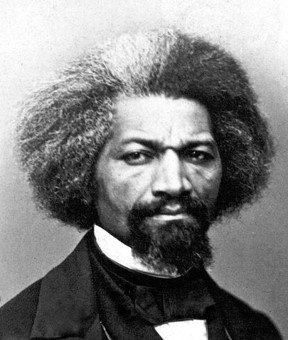
Frederick Douglass (1818 -1895)
Frederick Douglass (born Frederick Augustus Washington Bailey), (1817–1895) escaped slavery in Maryland to become a national leader of the abolitionist movement in Massachusetts and New York. He inspired admiration in anti-slavery activists for his powerful oratory and antislavery writings.
Douglass wrote three autobiographies, describing his life experiences as a slave: Narrative of the Life of Frederick Douglass, an American Slave (1845), My Bondage and My Freedom (1855) and Life and Times of Frederick Douglass (1881). Douglass supported women's suffrage and formed a coalition across racial and ideological divides. Frederick Douglass visited the UK to raise awareness across the UK of the horrors of slavery in 1845. He travelled across Great Britain, lecturing in churches, meeting with various British abolitionists. Many supporters tried to encourage Douglass to remain in England, but he returned to America in the spring of 1847, a free man after funds were raised to buy his freedom in the UK.
There are a few plaques dedicated to Frederick Douglass in the UK: the first is at the Imperial Hotel in Cork and was unveiled on August 31, 2012; the second is on the façade of the Waterford City Hall, unveiled on October 7, 2013. It commemorates his speech there on October 9, 1845. On Wednesday 20th February 2013 a blue heritage plaque was unveiled in South Kensington to honour the American abolitionist, Frederick Douglass. The plaque was unveiled on Nell Gwynn House, Whiteheads Grove, SW3 which is the site of the former home of British abolitionist George Thompson, who Frederick Douglass stayed with for a time in 1846, while lecturing in London on the horrors of the slave trade.
The Frederick Douglass Tribute was organised by the Nubian Jak Community Trust, in association with the United States High Commission in London. The tribute formed part of Black History Month Celebrations in the US, and was also supported by local dignitaries, councillors, members of the public, national and international press and media.
The reception opened at the Campbells Art Gallery in South Kensington at 35 Thurloe Street. The reception, exhibition displayed the work of 150 school students from five London schools which worked with NJCT in researching the life and times of Frederick Douglass.
This is a magnificent way to honour one of America’s greatest campaigners for equality and civil rights. The plaque will allow passers-by the chance to stop and reflect for a moment on Frederick Douglass’s life and achievements – and encourage them to discover the part British people played in his journey from slave to statesman. Minister Barbara Stephenson, Deputy Chief of Mission at the U.S. Embassy.
It is a privilege to honour the memory of Fredrick Douglass We should pay tribute to all Men (and indeed women) who like him have been so instrumental in achieving the level of freedom and equality regardless of gender religion or race enjoyed by those fortunate enough to live in the modern democracies. Nell Gwynn herself was on of the few who were able to take advantage of the newly won liberty for women to be allowed to act on stage and would no doubt have thoroughly approved of the greater liberties for women achieved thanks to the efforts of Frederick Douglass and his like . Anthony Brown, Chair of Nell Gwynn House Freehold.
It is pleasing and appropriate that during the second term of Barak Obama’s presidency, the man who set the president 150 years by being nominated for the position, should be honoured in the UK for his abolitionist activities and universal stance on human rights! NJCT.
Location: Nell Gwynn House, 5 Whitehead's Grove Kensington, London, SW3 3HA

